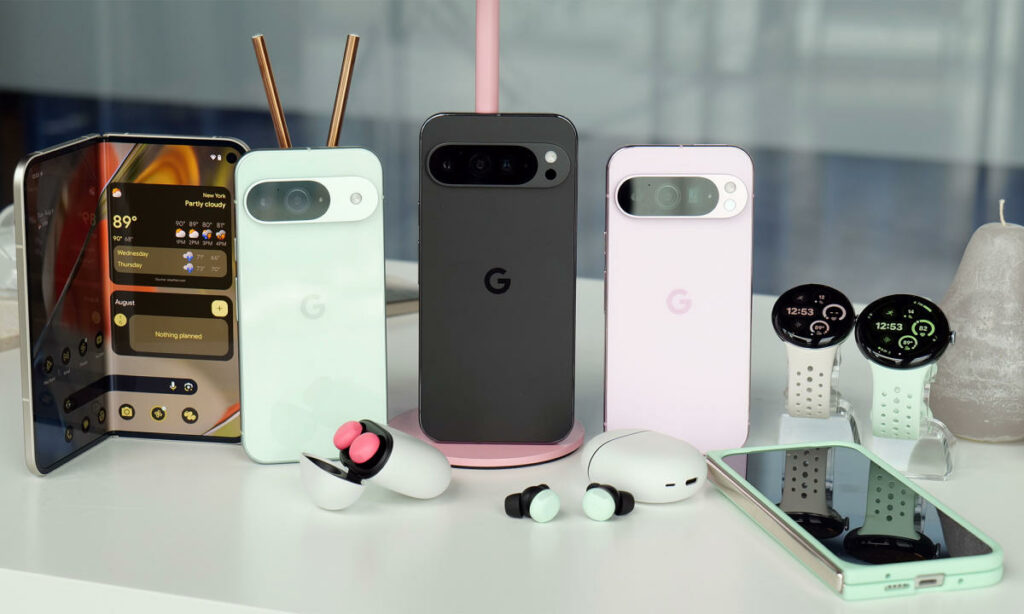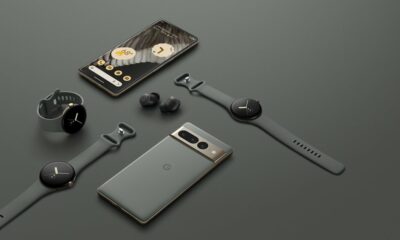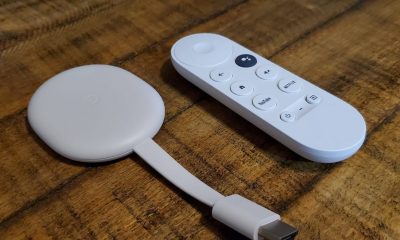News
The Pixel 9 event showcased new hardware, including refreshed Pixel 9 phones, Pixel Watch 3 and Pixel Buds Pro 2

Google just wrapped up its Made by Google hardware event, where they unveiled the refreshed Pixel 9 lineup and updates to other Google devices. While the Pixel event confirmed many leaks, Google also shared some surprises.
Here’s a roundup of all the exciting news from Google’s Pixel 9 event.
The Pixel 9 Series
Google just wrapped up its Made by Google hardware event, where they unveiled the refreshed Pixel 9 lineup and updates to other Google devices. While the Pixel event confirmed many leaks, Google also shared some surprises. Here’s a roundup of all the exciting news from Google’s Pixel 9 event. The Pixel 9 family is getting bigger. Now, instead of forcing you to choose between a small Pixel and a large “pro” Pixel, you have size options with the Pixel 9 Pro: 6.3 inches or 6.8 inches. What’s notable about the design language are the slight changes Google has made.
Gone is the iconic camera bar in favor of an elongated pill-shaped design for the hump on the back of the phone. On the front, the bezels around the display are smaller too. Google says these phones are twice as durable as the Pixel 8 generation—they’re wrapped in shatter-resistant Gorilla Glass Victus 2 and built around a 100 percent recycled aluminum frame. There’s no titanium here, unlike other high-end handsets like Apple’s iPhone 15 Pro and Samsung’s Galaxy S24 Ultra.
| Specs | Pixel 9 | Pixel 9 Pro | Pixel 9 Pro XL |
|---|---|---|---|
| Display: | 6.3 inch, 120 Hz, OLED, up to 2,700 nits | 6.3 inch, 120 Hz, LTPO OLED, up to 3,000 nits | 6.8 inch, 120 Hz, LTPO OLED, up to 3,000 nits |
| Processor and RAM: | Tensor G4 with 12 GB RAM | Tensor G4 with 16 GB RAM | Tensor G4 with 16 GB RAM |
| Storage: | 128 and 256 GB options | 128, 256, 512, 1 TB options | 128, 256, 512, 1 TB options |
| Battery: | 4,700 mAh | 4,700 mAh | 5,060 mAh |
| Cameras: | 50-MP wide, 48-MP ultrawide, 10.5-MP selfie camera | 50-MP wide, 48-MP ultrawide, 48-MP telephoto (5X), 42-MP selfie camera | 50-MP wide, 48-MP ultrawide, 48-MP telephoto (5X), 42-MP selfie camera |
| Updates: | 7 years | 7 years | 7 years |
| Extras: | VPN, 45W charging, Qi wireless charging, fingerprint and secure face unlock, DisplayPort | VPN, 45W charging, Qi wireless charging, fingerprint and secure face unlock, DisplayPort, Video Boost, Pro Controls, Google One AI Premium Plan | VPN, 45W charging, Qi wireless charging, fingerprint and secure face unlock, DisplayPort, Video Boost, Pro Controls, Google One AI Premium Plan |
| Colors: | Obsidian, Porcelain, Wintergreen, Peony | Obsidian, Porcelain, Hazel, Rose Quartz | Obsidian, Porcelain, Hazel, Rose Quartz |
| Price: | $799 | $999 | $1,099 |
The biggest distinction between the Pro models and the standard Pixel 9 is the camera tech. Both tiers of handsets share the same 50-megapixel primary camera and the same 48-megapixel ultrawide (all of which now support Macro Focus for close-up shots). Like last year, the Pixel 9 Pro series has a 48-megapixel telephoto camera offering 5X optical zoom. However, Google says this camera now also offers a 10X “optical-like” zoom, meaning you can get good-quality results from the digital zoom at that level, though we have yet to test that claim. The Pro cameras have a more advanced autofocus sensor too.
The 42-megapixel selfie camera in the Pro phones might impress more as it supports autofocus and has a claimed 30 percent improvement in light sensitivity while offering the widest field of view ever on a Pixel (103 degrees). You’ll be able to squeeze more people into the frame when you hold out your arm to take an ussie. The standard Pixel 9 is stuck with a 10.5-megapixel selfie camera, though this camera does support autofocus for the first time.
All three handsets are outfitted with 45-watt charging support (you’ll still need your own charging brick), which Google says fills the battery to 70 percent capacity in just 30 minutes of charging. There’s a modest battery bump here, though Google highlighted that the Pixel 9 enjoys a 20 percent battery life boost over what you get from the Pixel 8. Annoyingly, the phones do not support Qi2, the new wireless charging standard, which would have enabled a MagSafe-like wireless charging experience. You’ll have to make do with the less precise and slower Qi wireless charging.
They’re all powered by the new Tensor G4 processor with 12 GB of RAM in the Pixel 9 and 16 GB in the Pixel 9 Pro. Google says the processor is 20 percent faster when web browsing and speeds up app launches by 17 percent. It purportedly has better power efficiency and is optimized to run large language models like Gemini. Specifically, these are the first phones to run Gemini Nano With Multimodality. The convoluted name is something Google is using to indicate that the on-device AI models can discern not only text inputs, but also images, audio, and speech. These devices also support Gemini Live, the new service that lets you have real-time voice conversations with the chatbot.
All of these phones will still receive seven years of software updates. Google says anyone who buys the Pixel 9 Pro or Pro XL will receive a full year of the Google One AI Premium Plan for free, which includes 2 terabytes of cloud storage and access to Gemini Advanced. The Pixel 9 got a $100 price bump to $799, the Pixel 9 Pro costs $999, and the Pixel 9 Pro XL is $1,099. Preorders are live now and they officially go on sale on August 22.
Oddly, these phones are launching with Android 14, not Android 15, and Google did not share any details on when the next version of its mobile operating system will arrive.
The fourth Pixel is the second-generation Pixel Fold folding phone, officially called the Pixel 9 Pro Fold to match the rest of the lineup. Unlike the original, it shares many of the same specs as the latest-generation single-screen siblings. You’ll notice the front screen is no longer as wide and short—it matches the 6.3-inch screen on the Pixel 9 Pro. Google says apps are now better optimized for the screens with this change. Open it up and you get one of the largest displays on a folding phone at 8 inches. This internal screen can get much brighter too (though not as bright as the Pixel 9 Pro).
Google’s efforts went into making this device super thin, claiming it’s the thinnest folding phone you can buy, and while it’s certainly thin at 10.5 millimeters, it’s not as svelte as Honor’s Magic V2 RSR, which is a hair thinner at 9.9 mm. At 257 grams, it’s about 26 grams lighter than the original Pixel Fold, with an improved stainless steel hinge mechanism. For context, the Pixel 9 Pro is 8.5-mm thick and 198 grams.
The camera system still doesn’t quite match the quality you get out of the Pixel 9 Pro—there’s a 48-megapixel main camera, a 10.5-megapixel ultrawide, and a 10.8-megapixel telephoto with 5X optical zoom. The front and inner cameras are the same: a 10-megapixel selfie shooter.
Google Pixel Watch 3
Google’s Pixel Watch 3 comes in a larger 45mm option alongside the 41mm model. In addition to thinner bezels that offer more screen real estate, the Pixel Watch 3 has a new ultra wideband chip, a brighter display that hits up to 2,000 nits, and a boatload of new fitness features.
One of the most notable features coming to the Pixel Watch 3 is the ability to detect whether the wearer’s pulse has stopped, allowing it to call emergency services if the wearer doesn’t respond to a prompt to check in and it doesn’t sense any movement. This feature will roll out in Europe to start. The 41mm Pixel Watch 3 starts at $349.99 with Bluetooth, while the 45mm watch starts at $399.99. Both sizes will be available on September 10th.
Pixel Buds Pro 2
Not only are Google’s Pixel Buds Pro 2 smaller and lighter, but they now come equipped with 11-millimeter drivers and a new Tensor A1 chip that’s supposed to improve active noise cancellation (ANC). The new buds also have a wing fin design, which should help them stay in your ears during a workout, along with up to eight hours of audio playback with ANC enabled (or up to 30 hours with the case).
At $229, the Pixel Buds Pro 2 cost a bit more than their predecessors, which launched at $200. They start shipping on September 26th.
Gemini Live
Gemini Live, which Google first announced at I/O in May, is rolling out now to Gemini Advanced subscribers. The new voice chat option lets you ask Google’s AI assistant questions out loud, and it will respond using your choice of 10 different voices. Just like ChatGPT’s voice assistant, Gemini Live will let you talk conversationally, and you can even interrupt it mid-sentence.


















Recent Comments